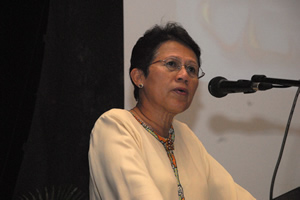TUESDAY, 28 JUNE 2011 00:00
 By S. Sivaselvam
By S. SivaselvamPics by Saliman Leman
PUTRAJAYA, 28 June 2011 – Preserving old Malay manuscripts through a home-grown software called JawiWare and developing a medical data mining system are just a couple of the projects UKM researchers are involved in as the country’s premier research university strives to make its mark in the rapidly-advancing world of Artificial Intelligence (AI).
Among other current research projects are on Fuzzy Tabu-based Optimisation for Job Shop Scheduling, University Timetabling, Malaysia Medical Data Repository, and MYNDA: A Data Mining Application Generator.
UKM Vice-Chancellor Prof. Tan Sri Dato' Wira Dr. Sharifah Hapsah Syed Hasan Shahabudin listed them when she opened the 1st International Multi-Conference on Artificial Intelligence Technology (M-CAIT 2011) here, which was organised by the Centre for Artificial Intelligence Technology (CAIT) at UKM’s Faculty of Information Science and Technology.
The three research groups at CAIT -- the Pattern Recognition Research Group (PR), the Data Mining and Optimisation Research Group (DMO) and the Knowledge Technology Research Group (KT) -- combined three conferences into one.
These are the International Conference on Pattern Analysis and Intelligent Robotic (ICPAIR 2011), the 3rd Conference on Data Mining and Optimisation (DMO11) and the 1st International Conference on Semantic Technology and Information Retrieval (STAIR2011).
Prof. Tan Sri Sharifah Hapsah hoped that a sharing of ideas among researchers, developers and practitioners at the multi-conference will not only disseminate state-of-the-art knowledge about Artificial Intelligence but will also help the three main research groups at CAIT to refine their application of AI techniques and methods to support various disciplines through research, teaching and consultancy.
With ICT being one of UKM’s niche research areas, she said the conference allows the researchers to exhibit UKM’s strengths in existing and new areas of ICT, specifically in Artificial Intelligence.
“At the same time we want to learn from the expressiveness and complexity of Artificial Intelligence technology for the benefit of the people whose lives can be enhanced by them,” she added.


Stressing that the research/innovation interface is very important to the university, Prof. Tan Sri Sharifah Hapsah said UKM has engaged vigorously with initiatives to develop a vibrant and sustainable R&D portfolio.
“We do this within our broader aim of creating stimulating learning environments for all who interact with us – our staff, our research students, our research partners and the many communities we work with,” she continued.
“I realise that there are several fundamental problems related to the science and technology of Artificial Intelligence technology. I hope you will create new synergies between the domains of enabling technologies and theoretical as well as pure research. Only by addressing these issues can we be in a position to contribute to the needs of society in a very unique way.”
The Vice Chancellor noted that after more than 50 years of research into Artificial Intelligence programming techniques, “we are not only seeing the dream of smart machines come true as part of our everyday life, but we are venturing into the area of biologically inspired computing or bio-inspired computing.
“From research that creates systems which can mimic the brain and its neural networks, such as mimicking human thought, understand speech and beat the best human chess player, we are now encompassing, among others, evolutionary algorithms, swarm intelligence, artificial immune systems, fractal geometry, artificial life, DNA computing and quantum computing.
“We are going closer and closer to the total human body and nature.”
The field of bio-inspired computing, a major subset of natural computation, loosely knits together subfields related to the topics of connectionism, social behaviour and emergence, she added.
“It relies heavily on the fields of biology, computer science and mathematics that enable us to use computers to model nature, and conversely use the model to improve the usage of computers,” she added.










No comments:
Post a Comment